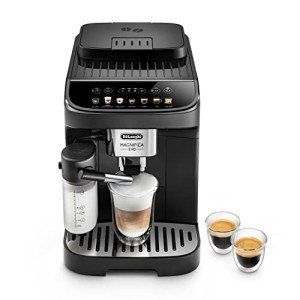The Ultimate Guide to Whole Bean Coffee Machines
In an age where coffee lovers have become increasingly discerning, the choice of a coffee machine has actually ended up being more critical than ever. Best Bean To Cup Coffee Machines have actually emerged as a favorite amongst major coffee drinkers, enabling them to draw out the freshest flavors from coffee beans. This short article looks into the intricacies of whole bean coffee machines, exploring their features, benefits, and factors to consider for the passionate coffee lover.
What is a Whole Bean Coffee Machine?
A whole bean coffee machine is designed to grind coffee beans right before brewing, guaranteeing optimum freshness and taste extraction. Unlike traditional coffee makers that depend on pre-ground coffee, these machines incorporate a grinder, which permits the user to select the grind size fit to their brewing technique, from espresso to French press.
Advantages of Whole Bean Coffee Machines
- Freshness: The primary advantage of using whole beans is that they retain their flavor longer than pre-ground coffee. Grinding just before brewing maintains the fragrant oils that contribute to the general flavor profile.
- Customization: Many whole bean machines enable users to adjust grind settings, water temperature, and developing time to produce a personalized cup of coffee that satisfies individual preferences.
- Quality Control: Whole bean coffee machines empower users to select top quality beans from various sources, making it easier to explore unique taste profiles.
- Flexibility: These machines deal with different brewing methods, allowing users to craft espresso, drip coffee, or specialty brews with ease.
- Convenience: Integrated grinders streamline the coffee-making process, lowering the need for extra devices and minimizing cleanup.
Secret Features to Consider
When selecting a whole bean coffee machine, numerous features must be considered:
Grinder Type:
- Burr vs. Blade: Burr grinders provide a more uniform grind, which is vital for consistency in taste, whereas blade grinders tend to produce uneven grinds.
- Brew Method Compatibility: Ensure the machine can accommodate the brewing technique chosen (e.g., espresso, pour-over, French press).
- Capability: Consider the hopper size for holding coffee beans; bigger capacities indicate less regular refilling.
- Interface: Look for machines with intuitive controls, enabling users of all skill levels to run them quickly.
- Upkeep: Machines that are simple to tidy and preserve will conserve time and ensure the durability of the gadget.
- Material Quality: Stainless steel and high-grade plastic offer resilience, while machines with glass elements tend to be less durable.
Popular Whole Bean Coffee Machines
| Brand name | Design | Mill Type | Capability (Cups) | Features | Price Range (₤) |
|---|---|---|---|---|---|
| Breville | BES870XL Barista Express | Burr | 8 | Espresso machine, steam wand | 600 - 700 |
| De'Longhi | EC702 | Pump | 10 | Dual boiler system, stainless steel | 300 - 400 |
| Cuisinart | DCC-3200P1 | Blade | 14 | 24-hour programmable, drip coffee | 50 - 100 |
| Rancilio | Silvia | Burr | 2 | Professional feel, steam power | 700 - 800 |
| Hamilton Beach | 49980A | Mixed | 2 | Single-serve, versatile developing | 30 - 50 |
How to Make the Most Out of Your Whole Bean Coffee Machine
To achieve the very best outcomes with a whole bean coffee machine, think about the following pointers:
- Quality Beans: Always pick top quality, fresh beans that fit your taste.
- Grind Size: Adjust the grind size based upon the developing technique. Finer grinds are appropriate for espresso, while coarser grinds work much better for French press.
- Brewing Temperature: Water temperature level need to normally be between 195 ° F and 205 ° F (90 ° C -96 ° C) for optimal extraction.
- Water Quality: Use filtered water for the very best taste and to lengthen the machine's life expectancy.
- Maintenance Schedule: Regularly tidy the mill and machine to avoid residue accumulation and guarantee consistent performance.
FAQs about Whole Bean Coffee Machines
1. Is a whole bean coffee machine worth the investment?
Yes, if you value the freshness and flavor of your coffee, buying a whole bean coffee machine is helpful. It enables for a richer and more fragrant cup of coffee compared to pre-ground options.
2. How do Best Bean To Cup Coffee Machines tidy my whole bean coffee machine?
Many machines include cleansing directions. Typically, you'll require to remove the grinder, tidy the hopper, and run a cleaning cycle with water. Use brushes particularly designed for this purpose.
3. Can I utilize pre-ground coffee in a whole bean machine?
A lot of whole bean coffee machines are particularly developed for whole beans; nevertheless, some might allow you to utilize pre-ground coffee. Seek advice from the producer's guidelines.
4. What is the best grind size for espresso?
A fine grind is generally chosen for espresso. Nevertheless, experimentation can help find the ideal grind size that matches your taste preferences.
5. How typically should I replace the coffee beans?
For optimum freshness, it is encouraged to use coffee beans within 2 weeks of opening after they have actually been roasted. Store them in an airtight container away from light and wetness.
A whole bean coffee machine can raise the coffee experience, supplying freshness, customization, and superior flavor. With many alternatives available, prospective buyers can discover a machine that fits their lifestyle and coffee choices. By thinking about the abovementioned functions, suggestions for optimization, and preserving a consistent cleaning regimen, users can savor every cup of newly brewed, fragrant coffee for many years to come. Whether for individual use or amusing guests, investing in a whole bean coffee machine is a step towards coffee excellence.

